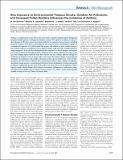| dc.contributor.author | Gilmour, M. Ian | |
| dc.contributor.author | Jaakkola, Maritta S. | |
| dc.contributor.author | London, Stephanie J. | |
| dc.contributor.author | Nel, Andre E. | |
| dc.contributor.author | Rogers, Christine Anne | |
| dc.date.accessioned | 2010-11-10T18:55:14Z | |
| dc.date.issued | 2006 | |
| dc.identifier.citation | Gilmour, M. Ian, Maritta S. Jaakkola, Stephanie J. London, Andre E. Nel, and Christine A. Rogers. 2006. How exposure to environmental tobacco smoke, outdoor air pollutants, and increased pollen burdens influences the incidence of asthma. Environmental Health Perspectives 114(4): 627-633. | en_US |
| dc.identifier.issn | 0091-6765 | en_US |
| dc.identifier.uri | http://nrs.harvard.edu/urn-3:HUL.InstRepos:4553296 | |
| dc.description.abstract | Asthma is a multifactorial airway disease that arises from a relatively common genetic background interphased with exposures to allergens and airborne irritants. The rapid rise in asthma over the past three decades in Western societies has been attributed to numerous diverse factors, including increased awareness of the disease, altered lifestyle and activity patterns, and ill-defined changes in environmental exposures. It is well accepted that persons with asthma are more sensitive than persons without asthma to air pollutants such as cigarette smoke, traffic emissions, and photochemical smog components. It has also been demonstrated that exposure to a mix of allergens and irritants can at times promote the development phase (induction) of the disease. Experimental evidence suggests that complex organic molecules from diesel exhaust may act as allergic adjuvants through the production of oxidative stress in airway cells. It also seems that climate change is increasing the abundance of aeroallergens such as pollen, which may result in greater incidence or severity of allergic diseases. In this review we illustrate how environmental tobacco smoke, outdoor air pollution, and climate change may act as environmental risk factors for the development of asthma and provide mechanistic explanations for how some of these effects can occur. | en_US |
| dc.language.iso | en_US | en_US |
| dc.publisher | National Institute of Environmental Health Sciences | en_US |
| dc.relation.isversionof | doi:10.1289/ehp.8380 | en_US |
| dc.relation.hasversion | http://www.ncbi.nlm.nih.gov/pmc/articles/PMC1440792/pdf/ | en_US |
| dash.license | LAA | |
| dc.subject | air pollution | en_US |
| dc.subject | asthma | en_US |
| dc.subject | cigarette smoke | en_US |
| dc.subject | climate change | en_US |
| dc.subject | diesel exhaust | en_US |
| dc.subject | environment | en_US |
| dc.subject | inflammation | en_US |
| dc.subject | mechanisms | en_US |
| dc.subject | ozone | en_US |
| dc.subject | particulate matter | en_US |
| dc.subject | pollen | en_US |
| dc.title | How Exposure to Environmental Tobacco Smoke, Outdoor Air Pollutants, and Increased Pollen Burdens Influences the Incidence of Asthma | en_US |
| dc.type | Journal Article | en_US |
| dc.description.version | Version of Record | en_US |
| dc.relation.journal | Environmental Health Perspectives | en_US |
| dash.depositing.author | Rogers, Christine Anne | |
| dc.date.available | 2010-11-10T18:55:14Z | |
| dash.affiliation.other | SPH^Exposure Epidemiology and Risk Program | en_US |
| dc.identifier.doi | 10.1289/ehp.8380 | * |
| dash.contributor.affiliated | Rogers, Christine Anne | |


